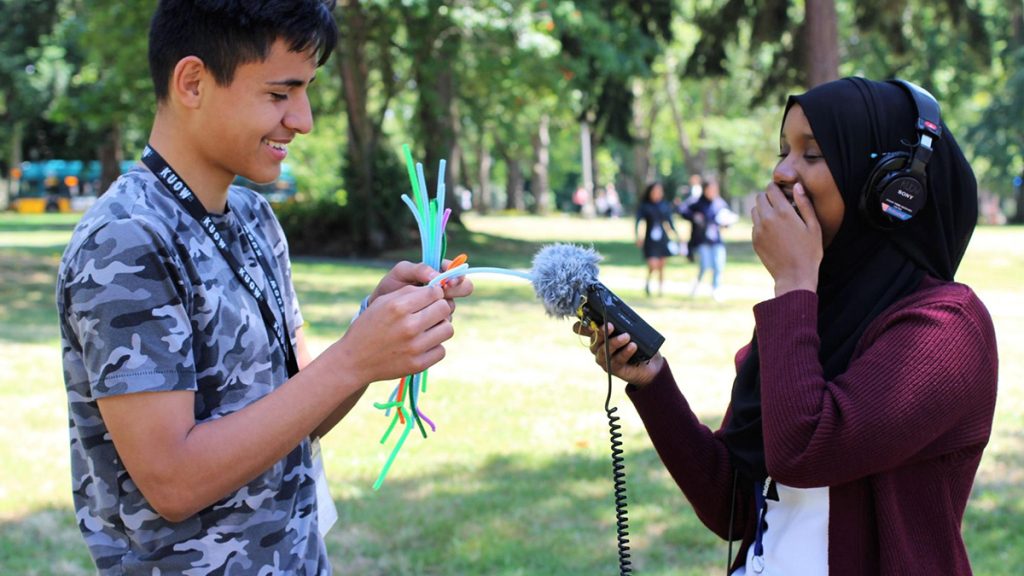
Eriberto Saavedra Felix (left) and Marian Mohamed record audio as part of an activity with KUOW’s RadioActive Youth Media on July 8, 2019 in Seattle, Washington. Photo: Kelsey Tolchin-Kupferer
Funding your youth media program
Youth media programs can open up new funding opportunities for public media stations
You’re ready to start a youth media program, but you have one big hurdle to clear: funding.
Whether you’re an NPR member station looking for money in the budget to sustain your existing teen-produced podcast, or you’re an independent producer writing grants to launch a media literacy workshop for middle schoolers, we’re here to help.
“I think most anything is fundable,” says Matt Albertson, a philanthropy officer at KUOW Public Radio who leads the major gifts team. “So it really depends on what you’ve decided your youth program is and the ‘why’ behind it. And if you’re passionate and clear about that, you will be able to find like-minded people who also think it’s a good idea, and who want to help see that idea come to fruition.”
After years of working for youth media programs with various funding models – from scrappy DIY programs to programs with large station budgets – what we’ve learned about funding can be condensed into three steps: 1) Clarify your program’s structure and purpose; 2) Find funding opportunities that match; and 3) Remember why it’s all worth it.
 | “Youth media opens up a whole new set of funding opportunities for public media stations.” |
Step 1: Clarify your program’s structure and purpose
Start your funding journey by clearly defining the structure, purpose, values and goals of your youth media program. This clarity will help you determine which funding sources are right for you.
ASK: What is the purpose of your youth media program?
Education programs, job training programs, and media production programs will all be funded differently. For example, your station may be more likely to put station funds toward a youth media program if youth are producing high-quality content for the station. And a job training program will be eligible for different grants than an arts or STEM education program. Once your program’s goals are clearly defined, you’ll be able to start looking for funding opportunities that match.
ASK: Where will this program be housed?
Will you operate as a program of a local NPR or PBS member station? As a standalone nonprofit? As a class or a club at a high school or college? As a program offering at an arts organization? Deciding where your program will be housed will inform some of your funding options.
Remember: You may have more freedom as a new standalone non-profit, but partnering with an existing organization — like a local TV or radio station, a museum, a community arts center, or a school — can give you access to money-saving benefits like comprehensive insurance policies, existing donor lists, payroll services, building space, a legal team, and more.
Step 2: Choose funding models that match
Your next step is figuring out which funding models are right for you, based on your program and your capacity.
“There is no limit to the different funding models you can choose from,” says Albertson. “You have to decide what you’re comfortable with and what to prioritize, because there will be pros and cons to all the options. Some options will be more resource-intensive than others. For example, it’s easy for KUOW to do a number of different things because we have a development team. It will look different if all your program staff are volunteers.”
Here are some of the most common methods for funding youth media programs. Many successful funding plans include some combination of these options.
Grants
“With grantors, youth media opens up a whole new set of funding opportunities for public media stations,” says Alberson. Many youth media programs are eligible to apply not just to grants focused on media, journalism and documentary, but also youth development, education, STEM and technology, job training, career exploration, innovation, arts, and more.
Grant considerations
- Capacity: Grant-writing is time intensive. Some local public service organizations, like universities and libraries, offer volunteer grant writing programs that you may be able to work with to help.
- Realistic metrics: If your program is a youth development program, the metrics for success you outline in your grant application should be focused on youth development, not, for example, the number of stories youth produce. Make sure the metrics that you put forward to grantors are aligned with your program’s actual goals, and that they’re realistic.
- Mission drift: Similarly, be aware of “mission drift,” or the temptation to change the goals of your program to fit a funding opportunity. Stay true to your mission and what you know you can do well, and find the grants that match.
- Sustainability: Grants typically offer a specific funding amount for a specific period of time. That means that you’ll likely be searching for and writing new grants regularly to continue your funding. “There are grantors who like to launch programs but not sustain them,” Albertson says. But even if a grantor doesn’t plan to fund your program past its initial phase, they may be able to connect you to other funding opportunities. “Remember,” he says, “they invested in your program because they want to see it succeed.”
- Matching: Look for opportunities to leverage grant matching. Here’s how it works: With matching funds, you agree to provide funding just like the grantor does, but through new contributions. It challenges you to broaden your base of support, but with the incentive that those who are joining in are having even more of an impact than they could individually. Often, volunteer time and donated materials (in-kind donations), not just financial donations, can count towards a match.
- Collaboration: You may be eligible for more grant opportunities if you partner up with other similar programs. “We’re stronger together,” says Albertson. “If all of the youth programs in the country could figure out ways to collaborate on funding together, then you could collectively apply for something like a Knight Foundation grant. Collaboration is difficult and it takes time, but if you can find that alignment, it can be very fruitful.”
Grant resources
- WHYY’s Public Media Stations and Youth Voices: A toolkit for launching youth media programs has a Funding and Grant Writing Guide specifically for youth media programs at public media stations.
Station operating budget
If your program is housed within an existing station or organization, you may be able to secure funding as a line-item in its budget.
Securing funding as a line-item in your station’s budget allows for three big wins:
- Youth program staff are free to focus their full attention on running high-quality youth media programs, instead of splitting their time between program management and the stress of scrambling for funding (grant writing, soliciting donations, etc.).
- The program can nimbly respond to youth needs as they arise, instead of being held to grant requirements. For example, when the Covid-19 pandemic hit, we saw grant-funded programs lose their funding because they could no longer satisfy the specific requirements their grants hinged on. Programs that were funded through their station’s operating budget, however, were able to pivot to meet youth and staff needs during a difficult time, without having to worry about losing funding.
- When a station fully funds their youth media program, it positions youth media as critical to the station. And because the youth program knows the money will be there next year, the youth program can grow and collaborate with other station departments, and become an expected and respected part of the station.
Station operating budget considerations
- Develop a good relationship with the fundraising team: Make sure the station or organization’s fundraising team knows what you’re up to! Sharing your youth program’s mission, values and goals — as well as photos and youth testimonials (with youth permission) – will allow the fundraising team to keep an eye out for potential funding sources that match. And it’s mutually beneficial — the fundraising team wants to amplify awesome things the station is doing.
- Consider reaching out to existing donors: Public media is made possible by audience support. The same people who donate to your station to fund your journalism may also be interested in funding your youth program. We’ve found that one donation does not cannibalize the other – instead, people who care about education may be excited to increase their donation to your station to support your station’s education program. New donation opportunities may even help better engage and retain existing donors.
Station operating budget resources
- The report Gen Z in the Room: Making Public Media By and With Youth for the Future by Elizabeth Rood and Mary Madden for the Joan Ganz Cooney Center has a section called ‘Unlocking funding through youth work,’ which includes reflections on youth program funding from a number of youth media program producers.
Sponsorships, underwriting and in-kind donations
Sponsorships and underwriting are an established way for public media programs to access funding. And you may be able to get program necessities like equipment, software, building space, and food through in-kind donations.
Sponsorships, underwriting and in-kind donations considerations
- Youth care who is funding their programs: Youth are going to notice if their program is funded by Big Pollution Inc., and they’re not going to like it. Be thoughtful about who you accept funding from.
- Involve youth in the funding process: If you have youth in your program who are interested in the business side of media, bring them on as collaborators! Youth may be able to work with business support teams to sell podcast underwriting spots to local organizations, produce promos, find local sponsors, and more.
- Big companies and local stores may sponsor equipment: Ask around for equipment sponsorship opportunities both at local businesses and at big corporations. Lots of places, big and small, are open to working out deals or offering discounts on equipment for youth-serving programs.
Sponsorships, underwriting and in-kind donations resources
- Having a workshop or event? A local or chain business may be interested in donating food or drinks.
- Adobe offers discounted software and grant matching for educational programs and non-profits
- Canon considers requests for donations for “youth support” programs.
Fee-for-service programs and other revenue-generation
Another way to fund your program is by finding ways to generate revenue. For example, we often hear adults in the community say, “I wish I could go to a media camp!” So maybe you put on a media production camp for adults, which they would pay a fee for, in order to fund youth programs.
Fee-for-service programs and other revenue-generation considerations
- Accessibility and equity: Any time a service costs money, it will exclude people from using it. Even pay-what-you-can programs are anxiety-inducing for some people and families. We do not recommend charging families a fee for your youth programs, even at a sliding scale. We believe youth should be paid for their time and work, not the other way around. Asking youth and their families to pay for media program participation in any capacity can be seen as exploitative.
- Capacity: You don’t want your revenue-generating programs to take too much time and resources away from your youth-serving programs. “Remember that time is an even more scarce resource than money,” says Albertson.
Step 3: Remember the work you’re putting in to secure funding is worth it
It is difficult to manage a public media or non-profit budget. And as a newsroom leader, it can be difficult to make the decision to allocate money to a youth program when you can, say, hire another reporter or hire another member on the development team or buy new equipment or increase staff salaries.
So is it worth it? And how do you make that call? We asked Kerry Swanson, chief operating officer at KUOW Public Radio.
“Investing in programs aimed at training young people is crucial for the future of public radio,” Swanson says. “Not only does it align with our mission to create and serve a more informed public, but it also addresses an aging listenership, reaches new audiences, diversifies our sources and coverage, more accurately represents our region on air, and increases media literacy in our region. Additionally, investing in youth media programs allows us to make a talent pipeline, which is essential for the growth and sustainability of public radio.”
Swanson says funding youth media programs is about the future: ensuring that public radio will continue to serve the public, and that democracy will continue to thrive.
“If public media is not going to invest the funds, who will? It is our duty as a public service organization to invest in programs that will empower the next generation and ensure the continuation of our mission,” he says. “I strongly believe that the benefits of youth media programs far outweigh the costs, and it is worth the significant investment.”
Funding is one section of our new guide for news radio stations who want to start their own youth media programs, which will be published in March 2023. Want to be the first to hear about the guide once it launches? Want to support or contribute? Got questions? Connect with us.


Comments